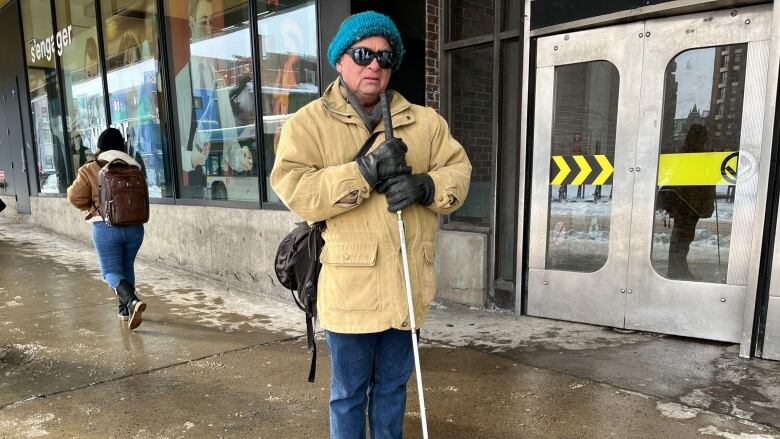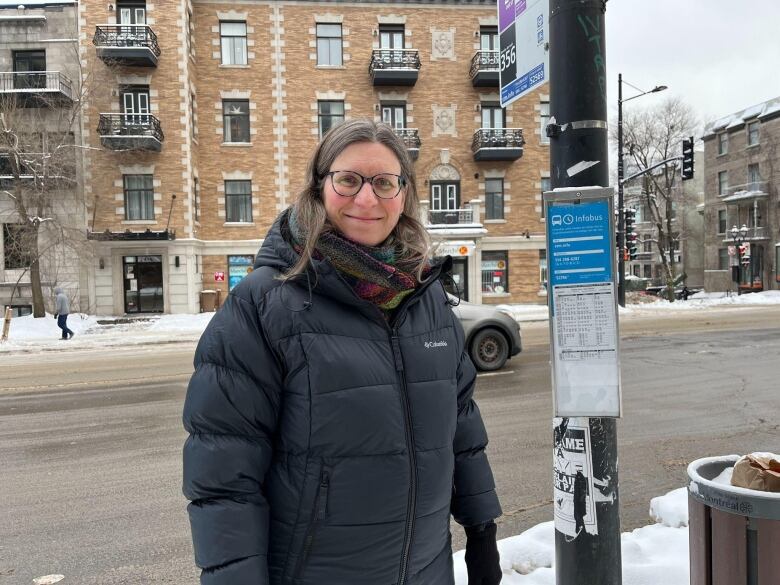Montreal short on safety for those with reduced mobility, study finds
It's also more difficult for those with low incomes to access public transit

For Yves-Marie Lefebvre, going blind has added a whole new dimension to exploring Montreal.
"It's given me another experience of life," he said.
But some areas are harder than others to navigate,he said, as many bus stops and Metro stations are difficult to reach.
The bus stop at the corner of Sherbrooke and St-Denis streets is an example of places he just can't go.
"It's impossible to cross it. There's no audible crossing light for a blind person," he said.
And Lefebvre isn't the only one struggling to navigate the city.
A new study by the Institut National de la Recherche Scientifique, research-oriented institute of the Universit du Qubec, suggests most bus stops, Metro and train stations in the Montreal region are hard to access for people with low income and for those with reduced mobility.
The study's lead researcher, Marie-Soleil Cloutier, said only 25 per cent of the some 22,000 stops and access points in greater Montreal are both safe and walkable.
Cloutier is a professor at the research institute's Centre Urbanisation Culture et Socit. She said downtown Montreal is usually easier to walk through, but more dangerous because of traffic.
Meanwhile in the suburbs, sometimes there are no sidewalks, but fewer cars.
More co-ordination needed
Cloutier said there are bus stops in places where there is no safe place to cross the street, and a passenger has to walk a few hundred metres to a traffic signal.
"Those are all issues that make the life of the people using transit more complicated," she said.
To Lefebvre, that means he needs to plan his every move.
"OK, today is snowing, so I have to stay at home. OK, so there is construction so I have to stay at home. OK, the audible crossing light doesn't work, I will stay at home," he said.

Cloutier said cities and transport agencies need to have more co-ordination so more people can access public transit safely.
Universal accessibility issues taken seriously, STM says
In a statement to CBC News, Montreal's transit authority, the Socit de transport de Montral(STM), said the issue of universal access has been apriority for several years and that everypossible limitationof transit users istaken into consideration.
It also said it has a set ofaccessibility criteria for bus stops and shelters. Those criteria include setting them up in a way that makes snow clearing efficient and buses easier to access and doing levelling work between the road and the sidewalk.
The STM also said it would reach out the IRNS to better understand the study's findings.
Hugo Bourgoin, a spokesperson for the city of Montreal, said in a statement that the safety of pedestrians and those with reduced mobility is a priority for the city, which continuously implements measures to improve security and accessibility.
"There is still work to be done to ensure universal accessibility across the entire city, but the city is firmly committed to this goal," he said.
He said it is essential that Montreal develops and implements "relevant and innovative solutions to eliminate barriers to participation and access to municipal services and environments" for all residents.
He said there is ongoing collaboration with STMto promote the accessibility of Metro stations.
The city's transportation and public works commission recently consulted the population on universal accessibility, he noted. That said, he added, the city is interested in reviewing the institute's study as a potential tool to raise awareness across the Montreal region.
Public transit agencies respond
As for the city's new light-rail network, universal accessibility has been a "fundamental priority" since its inception, according to Michelle Lamarche, spokesperson for CDPQ Infra.
A committee with universal accessibility groups was founded in 2019 to give feedback, improving the development plan, and the work is ongoing, Lamarche said.
Isabella BrissonUrdaneta, a spokesperson for the Autorit rgionale de transport mtropolitain (ARTM), said the ARTM is supporting its partners in their commitment to improving quality, safety and accessibility.
"Several stakeholders are involved in these issues, and we are working in close collaboration with our municipal partners to improve accessibility for vulnerable users," she said in an email.
Corrections
- A previous version of this story stated that CBC News did not hear back from the STM. In fact, the STM reached out to CBC on Wednesday to say it needed to talk with the INRS and get familiar with the study's findings before issuing a comment. On Thursday, the STM sent a more detailed response. The story has been updated.Jan 18, 2024 11:39 AM ET













_(720p).jpg)


 OFFICIAL HD MUSIC VIDEO.jpg)
.jpg)



























































































